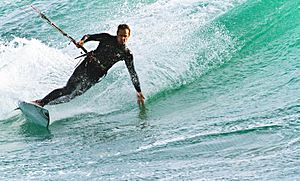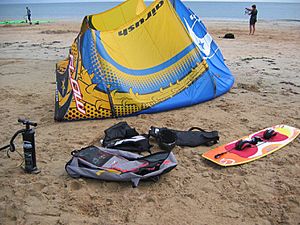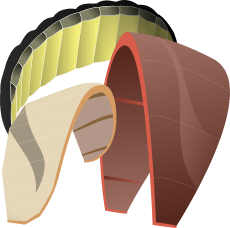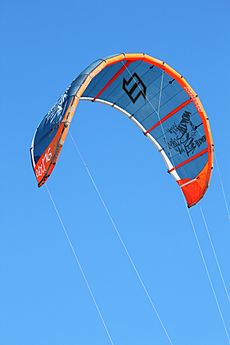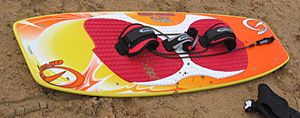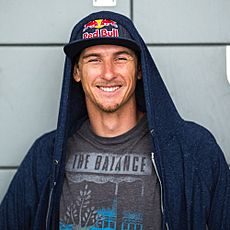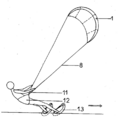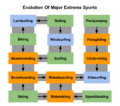Kiteboarding facts for kids

Kiteboarding or kitesurfing is an exciting extreme sport. It's like a mix of sailing, surfing, windsurfing, skateboarding, snowboarding, wakeboarding, and paragliding! In this sport, you use a large, special kite to catch the wind. This wind power then pulls you across water, land, or snow. It's often seen as a more affordable and easier sailing sport to get into.
Kiteboarding started to become popular in the late 1990s and early 2000s. Today, about 1.5 million people around the world enjoy kitesurfing. Each year, about 100,000 to 150,000 kites are sold.
Most kites used are called "leading edge inflatable" kites. They are connected to you by long lines (about 20 meters) and a control bar. You wear a harness that connects you to the control bar. You ride on a special board, which can be a "twin-tip" board (like a wakeboard) or a surfboard. Sometimes, people even use a foilboard that lifts them above the water! Many riders wear a wetsuit to stay warm in cool water. In the past, safety was a concern, but now, with better gear and lessons, it's much safer.
Contents
- Amazing Kitesurfing Records
- Where Can You Kiteboard?
- Different Ways to Kiteboard
- Learning Kitesurfing Techniques
- Understanding the Wind
- Great Kitesurfing Spots
- Kitesurfing Gear
- Staying Safe in Kiteboarding
- Kiteboarding Words and Phrases
- Kiteboarding vs. Windsurfing
- Kitesurfing World Champions
- Images for kids
- See also
Amazing Kitesurfing Records
Highest Jumps
Kiteboarders love to jump high! On February 19, 2017, Nick Jacobsen set a world record for the highest jump in Cape Town, South Africa. He jumped an incredible 28.6 meters high and stayed in the air for 8.5 seconds! Since then, others have broken this record. The current record for a single jump is 34.8 meters, set by Maarten Haeger.
Jesse Richman holds the record for the longest time spent in the air, called "hangtime." He stayed up for 22 seconds in San Francisco, California. Airton Cozzolino holds the record for strapless hangtime (without foot straps) at 19 seconds.
Fastest Speeds
Kitesurfers can go super fast! On October 3, 2008, French kitesurfer Sébastien Cattelan was the first sailor to go faster than 50 knots (about 92.6 km/h). He reached 50.26 knots in Namibia. The next day, Alex Caizergues, also from France, broke that record with 50.57 knots.
On November 13, 2017, Alex Caizergues set a new world speed record in France. He reached an amazing 57.97 knots, which is about 107.36 km/h!
Longest Distances Traveled
Kitesurfers have also completed some very long journeys. Here are a few amazing trips:
- In 2006, Kirsty Jones crossed from Lanzarote (Canary Islands) to Tarfaya, Morocco. She traveled 225 km in about nine hours!
- In 2008, Eric Gramond crossed 419.9 km from Fortaleza to Parnaíba in Brazil over 24 hours.
- On July 19, 2013, Bruno Sroka traveled 444 km between France and Ireland.
- On July 7, 2015, Francisco Lufinha completed an incredible 874 km journey from Lisbon to Madeira.
Amazing Journeys Around the World
Louis Tapper holds the record for the longest kite journey. He traveled 2000 km between Salvador and Sao Luis in Brazil in July/August 2010. This trip took over 24 days of kitesurfing and he did it all by himself, with just one kite and a backpack!
Constantin Bisanz, from Austria, crossed the Bering Strait in 2011. This is an 80 km stretch of water between Alaska (USA) and Russia. He completed the crossing in just two hours!
In 2013, a team of six kitesurfers crossed the entire Atlantic Ocean! They traveled about 3500 miles (5600 km) from the Canary Islands to the Turks and Caicos Islands. Each person kitesurfed for four hours every day.
Where Can You Kiteboard?
Kiteboarding can be done on water, land, or snow!
- On water: You use a kiteboard, which is like a small wakeboard or surfboard.
- Kitesurfing: This is a special type of kiteboarding where you ride waves using a surfboard.
- On land: You use a shorter, lighter board, or even a buggy for sand. This is great practice for kitesurfing!
- On snow: This is called snowkiting. You use skis or a snowboard.
Different Ways to Kiteboard
There are many different styles of kiteboarding. Some styles are:
| Style | What it is | Similar sports |
|---|---|---|
| Freeride | This is the most popular style. It's all about having fun and learning new things. You use a "twintip" board and kites that are easy to relaunch and work in many wind conditions. | |
| Freestyle | You use the kite and board to get "big air" (jump high) and do cool tricks while in the air. This style is also used in competitions. | |
| Wave-riding | This combines kiteboarding with surfing. You ride waves using a directional board, often a surfboard. You follow the wave, so the kite's pull is less important. | Surfing, tow-in surfing |
| Wakestyle | This involves tricks and jumps, often using a wake-style board with bindings. You might even use ramps! It's similar to wakeboarding. | Wakeboarding |
| Jumping or Airstyle | This is about jumping very high and doing tricks. Sometimes you do "kiteloops" for extra hang-time. Big Air is an extreme version where riders go out in very strong winds and do risky moves like "megaloops." | — |
| Wakeskate | You use a board without straps, like a skateboard. This is often done on flat water. | Skateboarding |
| Course racing | These are races around a course, like a yacht race. You need speed and good tactics. Special race boards with long fins are used, and sometimes foilboards. | Windsurfing |
| Slalom | This is a race downwind around buoys. Riders are often grouped into "heats," with winners moving to the next round. | Windsurfing |
| Speed racing | The goal is to go as fast as possible over a distance of 500 meters. Special speed boards are used. | |
| Park Riding | Riders use obstacles, like those found in wakeboarding parks, to perform tricks. | |
| Foiling | This involves a "hydrofoil" attached to the board, which lifts the board completely out of the water. This allows you to ride in very light winds and go much faster. |
Learning Kitesurfing Techniques
Kiteboarding can be tricky at first, so it's best to take lessons from a professional instructor. They will teach you important skills like:
- How to handle and care for your kite, lines, and control bar.
- Understanding how the wind works and how to steer your kite.
- How to launch your kite into the air and land it safely.
- "Body dragging," which is being pulled through the water without your board.
- How to "water start" and get up on your board.
- How to rescue yourself if your kite falls in the water.
- Safety rules and how to navigate with other people on the water.
- How to ride upwind and downwind.
- Basic turns and jumps.
- Doing "board grabs" and other tricks while jumping.
Understanding the Wind
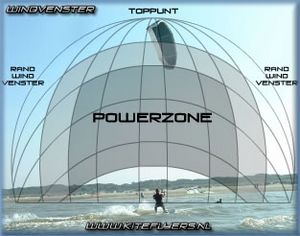
The wind is super important in kiteboarding!
Wind Strength and Kite Sizes
Kiteboarders choose their kite size based on how strong the wind is. Stronger winds mean you need a smaller kite so you don't get pulled too hard. You can check the wind strength using a special tool called an anemometer or by looking at visual clues, like how the water looks (using the Beaufort scale). Modern kites have a "depower" option that lets you reduce the kite's power, making it safer and easier to handle.
Wind Direction and Speed
Winds that blow across the shore or slightly towards the shore are usually best for kiteboarding. Winds blowing directly offshore (away from the shore) can be dangerous because you might get blown far out. Winds blowing directly onshore (towards the shore) can also be tricky, as you might get pushed onto land.
It's important to know both the wind direction and its speed. For experienced riders, winds up to 33 knots are usually safe. Beginners should avoid winds stronger than 15 knots. Most boards and kites need at least 11 knots of wind to work well.
Apparent Wind
When you move your kite, it creates its own wind, called "apparent wind." This is the wind the kite actually feels. Even if the true wind (the wind measured from the ground) is light, by moving your kite fast, you can make it feel a lot more wind and generate more power. This is why kiteboarding is so unique – you can create power even when you're not moving on your board yet!
Wind Power and Kite Paths
Kiteboarders get power by moving their kite through a large area of air. To get more power, you can move the kite in an "S-shape" path across the sky. If you need a lot of power, you can "loop" the kite in a big circle. This is an advanced move and can be very powerful!
The length of your lines also matters. Longer lines let you reach higher winds, which are usually stronger. But longer lines also make the kite slower to respond. Kitesurfers who ride waves often use shorter lines so they can react faster to the waves. Beginners usually start with shorter lines for safety.
The Wind Window
Imagine a giant half-bubble of air downwind from you. This is called the "wind window." Your kite can only fly within this area. If your kite goes outside this window, it will lose power and fall. The wind window moves with you as you ride. This movement helps you control your speed and direction, allowing you to ride upwind (against the wind) or downwind.
Great Kitesurfing Spots
Any place with steady winds (10 to 35+ knots), large open water, and good launch areas is perfect for kitesurfing. Many popular spots are on ocean beaches, but you can also kite on big lakes, inlets, and even some rivers.
- Boracay in the Philippines has constant side-onshore winds and shallow, turquoise water.
- Cumbuco in Brazil has strong side-shore winds almost every day.
- Maui in Hawaii offers warm water, steady winds, and gentle waves.
- Sharm El Sheikh in Egypt has shallow, flat water and strong winds most days.
- Tarifa in Spain has a long, wide sandy beach with good winds from May to October.
- El Medano in Tenerife has constant north-east winds all year round.
- Kappalady in Sri Lanka is known for steady, fast winds for nine months of the year.
-
Kitesurfing with endangered Black sea common dolphins off Sochi
-
Kitesurfing in Fuerteventura
-
Kitesurfing in Noordwijk in the Netherlands
Kitesurfing Gear
Kiteboarding gear has become more affordable, especially used equipment. It's also easy to transport and store because kites fold up and boards are smaller than many other water sports boards.
Power Kites
There are two main types of kites: leading edge inflatables (LEI) and foil kites.
Leading Edge Inflatables (LEI)
LEI kites are made of fabric with inflatable plastic tubes. These tubes give the kite its shape and help it float if it lands in the water. LEI kites are very popular because they respond quickly, are easy to relaunch from the water, and are tough.
Around 2005, "Bow kites" (also called "flat LEI kites") became popular. These kites have a special shape and bridle (lines) that let you change their power a lot. This makes them very safe and easy to relaunch. They also work well in a wider range of wind conditions.
Foil Kites
Foil kites are made mostly of fabric, like a paraglider. They have air pockets that fill with air to give them lift. Foil kites don't need to be pumped up manually, which saves time.
There are "open cell" and "closed cell" foil kites. Open cell kites are hard to relaunch from the water if they get wet. Closed cell kites have valves that keep air inside, so they stay inflated and are easier to relaunch from the water.
Kite Sizes
Kites come in many sizes, from very small (0.7 square meters) to very large (21 square meters or more). Bigger kites have more power. Smaller kites can be flown faster in strong winds. Most kiteboarders have one to three kites (often around 7-12 square meters) to handle different wind conditions. Lighter riders use smaller kites, and heavier riders use larger kites.
Other Important Gear
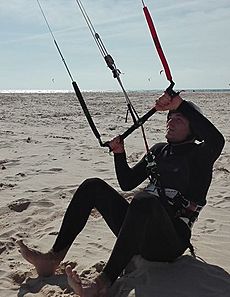
- Flying lines: These are strong lines (7 to 33 meters long) that connect your control bar to the kite. Most kites use 3, 4, or 5 lines.
- Control bar: You hold this bar to steer the kite. Pulling the ends makes the kite turn. It also has a "chicken loop" to connect to your harness and safety systems.
- Kite harness: This is worn around your waist or seat. It connects you to the control bar, taking the pull off your arms and spreading it across your body. This helps you do jumps and tricks.
- Kiteboard: This is the board you ride on. There are different types, including "twin-tip" boards (which can go in both directions), directional surf-style boards, and hydrofoil boards. Twin-tip boards are the easiest for beginners.
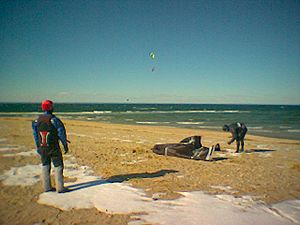
- Wetsuit: Many kitesurfers wear a wetsuit to stay warm, protect against marine life, and prevent scrapes. In very cold water, some use a dry suit.
- Safety hook knife: This small knife is essential for cutting tangled lines in an emergency.
- Helmet: Always wear a helmet to protect your head from bumps and falls.
- Personal flotation device (PFD) or impact vest: These vests help you float and protect your body from impacts.
- Board leash: Some riders use a leash to keep their board close, but it can be risky if the board snaps back. If you use one, always wear a helmet.
- Signaling devices: A whistle or waterproof phone can be helpful if you need rescue.
- Buddy: It's always a good idea to kiteboard with a friend who can help you launch your kite and assist in an emergency.
- GPS: A GPS device can track your speed and distance.
Staying Safe in Kiteboarding
Kiteboarding is exciting, but it's important to be safe! Kites are powerful and can lift you high or pull you fast. An uncontrolled kite can be dangerous, especially near obstacles. Taking professional lessons and using good judgment and safety gear will help you avoid problems.
Weather Awareness
Knowing the weather is key to safe kiteboarding. Always check the forecast and understand wind conditions. Avoid kiting near storm fronts, as winds can change very quickly and become dangerous.
Important Safety Tips
- Keep a safe distance from other people, buildings, trees, and power lines.
- Don't jump in shallow water or near objects.
- Watch out for other kiteboarders, windsurfers, and boats.
- Try not to kiteboard alone. Always have a friend nearby.
- Avoid kiting in winds that blow directly offshore unless there's a rescue boat.
- Be aware of marine life like jellyfish.
- Always use safety equipment like a helmet, impact vest, and hook knife.
- Practice how to "depower" your kite (reduce its pull) and how to rescue yourself if your kite falls in the water.
Kitesurfing Safety Rules
Just like driving a car or riding a bike, there are rules for kiteboarding to keep everyone safe.
- Be careful: Always assume others might not know the rules. Give them space and make your intentions clear.
- Waterstarters have priority: If someone is just starting from the beach, they have the right of way over riders coming in.
- Kite High Rule: If you are upwind (closer to where the wind is coming from), keep your kite high. If you are downwind, keep your kite low. This prevents lines from tangling.
- Clearance Rule: When jumping, you need at least 50 meters of clear space downwind and 30 meters upwind. A jumper never has the right of way.
- Starboard Rule: If two kiters are coming towards each other, the kiter with the wind coming from their right side (starboard) has the right of way. The other kiter should move out of the way. You can shout "starboard!" to let others know.
- Boating and Surfing Rules: Kitesurfers are like sailing boats, so general boating rules apply (e.g., stay away from swimmers). Also, surfing rules apply, so the person closest to the wave's crest has the right of way.
Kiteboarding Words and Phrases
- Air time: How long you stay in the air when jumping.
- Apparent wind: The wind speed the kite feels as it moves through the air.
- Back stall: When the kite stops moving forward and falls backward.
- Big air: Doing a very high jump using the kite's lift.
- Body dragging: Being pulled through the water without your board.
- Boost: To suddenly get lifted into the air.
- Chicken loop: A loop on the control bar that connects to your harness.
- De-power: To reduce the kite's power, usually by adjusting its angle.
- Downwind: The direction the wind is blowing towards.
- Downwinder: A trip where you ride from one point to another downwind.
- Edge: Tilting your board into the water to control direction and speed.
- Freeride: Kiteboarding without doing tricks, just enjoying the ride.
- Freestyle: Doing tricks and jumps, often with "big air."
- Goofy: Riding with your right foot forward.
- Guinea pig / Wind-dummy: Someone who goes out first to test the wind.
- Heel side: The side of the board where your heels are.
- Hindenburg: When the kite falls out of the sky because it loses tension in the lines.
- Hot launch: Launching the kite quickly with maximum power (can be dangerous).
- Kiter: The person riding the kite.
- Kiteloop: Looping the kite through the "power zone" for extra pull.
- Kitemare: A dangerous kiteboarding accident.
- Launch: Getting the kite into the air.
- Lofted: Getting lifted high into the air by a strong gust of wind.
- Luff: When the air stops flowing smoothly over the kite, causing it to flap and fall.
- Mobe: A type of wakestyle trick involving a spin and flip.
- Nuking: When the wind is blowing extremely strong (30-40 knots).
- Offshore: Wind blowing from the land towards the water.
- Onshore: Wind blowing from the water towards the land.
- Overpowered: Having too much power from the kite, usually due to strong wind or a kite that's too big.
- Pop: Getting height above the water using only the board and line tension.
- Power zone: The area in the sky where the kite has the most pull.
- Raley: An unhooked trick where the rider extends their body like Superman.
- Regular: Riding with your left foot forward.
- Re-launch: Getting the kite back in the air after it crashes.
- Self rescue: A way to use your kite to help you swim back to shore if you get stuck.
- Send it: To move the kite aggressively for more power.
- Schlogging: Riding very slowly because there isn't enough wind.
- Side offshore: Wind blowing partly away from the shore.
- Side onshore: Wind blowing partly towards the shore.
- Side shore: Wind blowing parallel to the shore (often ideal).
- Spreader bar: A metal bar on your harness that holds the chicken loop.
- Stomp: To successfully land a trick.
- Surfstyle: Riding waves using a surfboard.
- Tack: The direction you are sailing.
- Tea-bagging: Bouncing in and out of the water due to light or gusty wind.
- Toe side: The side of the board where your toes are.
- Underpowered: Not having enough power from the kite, usually due to light wind or a kite that's too small.
- Unhooked: Riding without the chicken loop attached to your harness.
- Upwind: The direction the wind is blowing from.
- VaS conditions: "Victory at Sea" – very rough water with big waves.
- Wakestyle: A style using bindings (like wakeboarding boots) and doing powerful tricks close to the water.
- Walk of shame: Having to walk back up the beach because you couldn't ride upwind.
- Zenith: The position of the kite directly overhead, where it has neutral power.
Kiteboarding vs. Windsurfing
Kiteboarding and windsurfing are both awesome wind sports, but they have some differences!
| Kiteboarding | Windsurfing | |
|---|---|---|
| Record Speed | 55.65 knots (world record) | 55.50 knots (world record) |
| Riding Upwind | You can ride about 70° from the wind direction on a twin-tip board. You lean hard on the board's edge to go upwind. | You can ride about 45° from the wind direction. The board stays flatter, and the fin helps you go upwind. |
| How it Works | The kite can move much faster than your board, creating lots of power. You can pump the kite to get power even when standing still. | The sail and board move at the same speed. You might pump the sail to get going, but they are connected. |
| Physical Effort | The kite's pull goes to your harness, so you mostly use your arms to steer. It's like light cardio exercise. | Without a harness, it takes a lot of arm strength. With a harness, it's easier, but you still use more muscle to maneuver. |
| After Falling | The kite usually stays in the air, making it easy to get pulled back onto your board. | In light winds, you pull the sail out of the water. In stronger winds, you "water start" by letting the wind pull you up. |
| Turning | Most kiteboards can go both ways, so you just switch your body position. For directional boards, you need to learn to "jibe" or "tack." | You have to learn to "tack" (turn into the wind) or "jibe" (turn away from the wind) and switch your feet. |
| Jumping | You can use the kite to jump high without needing a wave. Jumping is relatively easy to learn. | You need good forward speed and often a wave to jump. Jumping takes more skill. |
| Aerobatics | Many tricks can be done without changing the kite's position much. Beginners can try basic tricks fairly quickly. | The sail's position changes a lot during tricks. It's more complex and done by very experienced riders. |
| Clearance Needed | You need at least 50 meters downwind and 30 meters upwind of clear space because of the kite lines and potential for high jumps. | No kite lines, so less clearance is needed. You can stop quickly by letting go of the sail. |
| Learning Curve | You can learn kite control on land. Once on water, you need an instructor. After the basics, you progress quickly. | Learning is gradual. You can practice on land or water. It takes a lot of practice to get good. |
| Equipment Safety | If something breaks, you can "self-rescue" back to shore. If all else fails, you might have to swim to shore. | The board and sail help you stay out of the water. You should almost never leave your board. |
| Transporting Gear | A kite and board fit in most cars. You might need 2-3 kites and 1 board. | The board and mast are long and often need a roof rack. You might need several sails and boards for different conditions. |
Kitesurfing World Champions
Here are some of the amazing freestyle world champions in kiteboarding:
| Year | Men | Women |
|---|---|---|
| 2022 | Gianmaria Coccoluto (Italy) | Mikaili Sol (Brazil) |
| 2021 | Arthur Guillebert (France) | Mikaili Sol (Brazil) |
| 2020 | No title crowned | No title crowned |
| 2019 | Valentine Rodriguez (Colombia) | Mikaili Sol (Brazil) |
| 2018 | Carlos Mario Bebe (Brazil) | Mikaili Sol (Brazil) |
| 2017 | Carlos Mario Bebe | Bruna Kajiya |
| 2016 | Carlos Mario Bebe | Bruna Kajiya |
| 2015 | Liam Whaley | Gisela Pulido |
| 2014 | Christophe Tack | Karolina Winkowska |
| 2013 | Alex Pastor | Gisela Pulido |
| 2012 | Youri Zoon | Karolina Winkowska |
| 2011 | Youri Zoon | Gisela Pulido |
| 2010 | Andy Yates | Gisela Pulido |
| 2009 | Kevin Langeree | Bruna Kajiya |
| 2008 | Aaron Hadlow | Gisela Pulido |
| 2007 | Aaron Hadlow | Gisela Pulido |
| 2006 | Aaron Hadlow | Kristin Boese |
| 2005 | Aaron Hadlow | Kristin Boese |
| 2004 | Aaron Hadlow | |
| 2003 | Martin Vari | Cindy Mosey |
| 2002 | Cindy Mosey | |
| 2001 | Martin Vari |
Images for kids
-
Peter Lynn lifting a kite in Dieppe, September 1988
-
Laird Hamilton demonstrated kitesurfing in 1996
See also
 In Spanish: Kitesurf para niños
In Spanish: Kitesurf para niños


